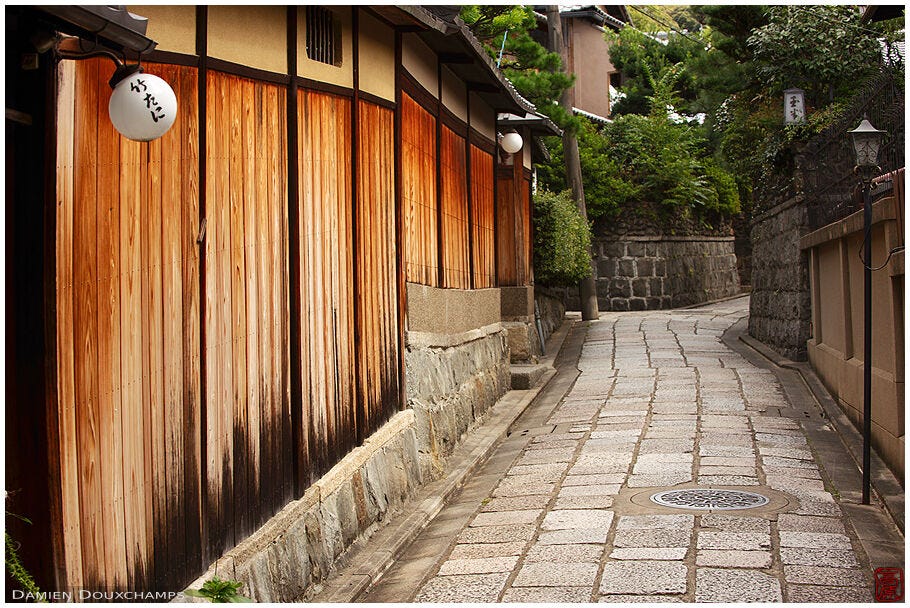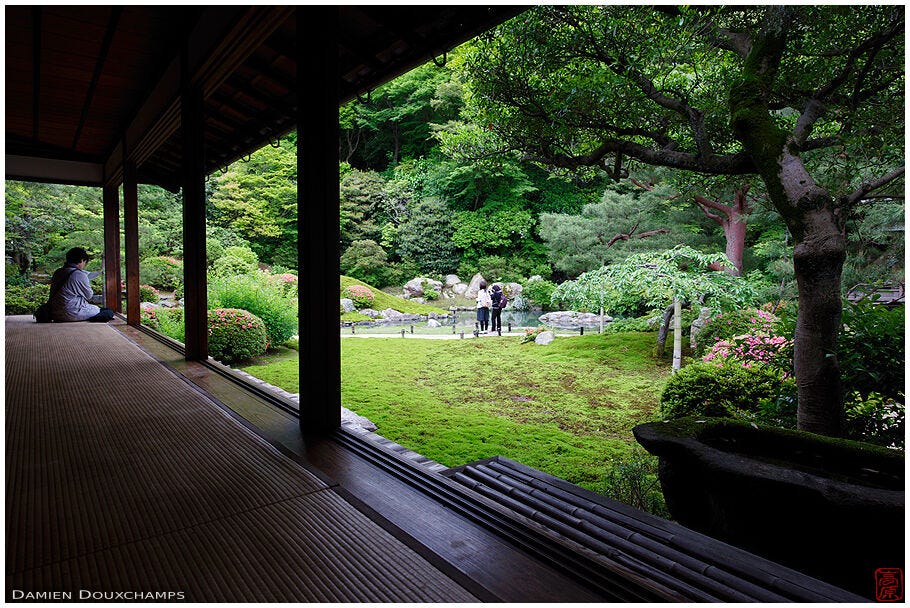NY Magazine: "Kyoto Loveliest Tourist Trap on Earth"
Responding to Reeves Wiedeman's "Zero Zen" article
If you live in New York, you’ve probably heard about New York Magazine’s recent piece on Kyoto titled “Zero Zen: A great exchange rate, ChatGPT, and kimono-wearing bros have turned Kyoto into the loveliest tourist trap on earth” (June 30, 2025). I wasn’t surprised by the piece — the author, Reeves Wiedeman, reached out to me before visiting Kyoto this past spring, and we spoke at length.
Peaceful Zen temple in Kyoto: Kennin-ji. Damien Douxchamps photo.
Wiedeman told me that New York Magazine wanted to write about overtourism, and Kyoto had been chosen as the target. It was clear the conclusion had already been baked into the assignment. Still, I hoped to broaden his perspective and offer some practical ways visitors could minimize their impact on the city. Unfortunately, the article turned out exactly as I feared.
Let’s look at a few key sentences. Here’s the opening paragraph:
“This is painful,” Maggie James told me as we took a stroll through Gion, the famous geisha district in Kyoto. It was a warm April night, and James, a high-end local fixer for jet-setters visiting the city, was giving me a tour of the neighborhood, which had become emblematic of the plague afflicting Kyoto and, increasingly, much of the world: too many tourists. Gion’s quiet streets lined with lanterns and low-slung wooden machiya townhouses were now filled with foreigners preening in polyester kimonos they had paid $20 to rent for the day. “None of them are Japanese,” James said, pointing to a group of men in elaborate getups. “These guys are wearing full-on shogun shit.”
Wiedeman chose Maggie James as his guide during his week in Kyoto. Elsewhere in the article, James boasts about clients who booked seven suites at the Aman (including rooms for their nannies) and another planning to fly in 30 guests on private jets for a party. Wiedeman’s “tour” of Kyoto involved visiting places like Hanamikoji — the busiest part of Gion — and watching ordinary tourists enjoy themselves, often through a lens of clear disdain. James even describes one such scene as “hell.”
It’s understandable that for luxury travel fixers like James and her billionaire clients crowds can be frustrating. But the elitist attitude on display is troubling. Is travel to beautiful, culturally rich cities something that should be reserved for the ultra-wealthy? Should the privileges of airline lounges, first-class seats and five-star hotels be extended to public spaces and historic districts? Should ordinary travelers be excluded from the world’s great temples, museums, and monuments so the 1% can enjoy them in peace?
Ishibei-koji Lane. Damien Douxchamps photo.
Consider this: The tourists “preening in polyester kimonos” were probably having the time of their lives. They were likely staying in affordable hotels, eating excellent food at reasonable prices, and admiring the city’s remarkable beauty. Dressing up in traditional garb may be a little cheesy — but it’s far from a cultural offense. If anything, it’s a form of admiration.
If you’re a regular reader of this newsletter, you know that I take overtourism seriously and often offer practical tips for avoiding crowds and minimizing impact on locals. This isn’t out of disdain for fellow travelers — it’s because we prefer quieter places and believe our clients do too.
One striking irony of Wiedeman’s piece is the title: “Zero Zen.” In reality, Kyoto is home to two of the most important Zen Buddhist sects (Rinzai and Obaku), as well as some of Japan’s most beautiful Zen temples — Daitoku-ji, Tofuku-ji, Nanzen-ji, and many others. It is arguably the best place in the country to experience zazen, the core meditation practice of Zen. Wiedeman gives no indication that he explored any of this — despite my encouragement to do so.
I don’t entirely blame Wiedeman. As a former freelance journalist, I understand that editors often assign a story with a predetermined angle. Still, it’s disappointing that he didn’t even attempt to explore a different side of Kyoto. Had he walked just 10 minutes from the bustle of Hanamikoji, he might have discovered Ishibei-koji (the most beautiful lane in Kyoto), Kennin-ji Temple (a superb Zen temple), and the tranquil gardens of Shoren-in — all typically calm and uncrowded.
Shoren-in Temple garden. Damien Douxchamps photo.
For what it’s worth, here’s the comment I left under Wiedeman’s article. I also sent it to the editors of New York Magazine. Time will tell if they publish it.
I was disappointed to read Reeves Wiedeman’s “Zero Zen” article (June 30, 2025). I lived in Kyoto for 20 years and now run a tour company and website focused on the city. While researching the article, Reeves reached out to me, and I spent over an hour — along with several follow-up emails — explaining a central point: that only about ten places in Kyoto are consistently overcrowded, while the vast majority of the city is often overlooked by tourists.
I provided Reeves with numerous suggestions for beautiful, lesser-known places where visitors can experience the quieter side of Kyoto. Yet based on his article, he seems to have ignored all of these recommendations, instead visiting the very sites I urged him to avoid — often in the company of luxury “fixers” who arrange tours for billionaires and expressed open disdain for ordinary travelers.
Imagine if a foreign travel writer visited New York City, went only to Times Square, the Empire State Building, and the Statue of Liberty, and then declared the city “the world’s worst tourist trap.” The editors of New York Magazine would rightly be appalled to see their city reduced to a caricature.
It seems clear that the editors sent Reeves to find proof of overtourism in Kyoto, and he delivered the story they wanted. But in doing so, they’ve done a disservice to their readers — many of whom may now choose to skip the most culturally rewarding city in Asia based on a narrow, sensationalistic portrayal.
For those interested in seeing some of the less visited sides of Kyoto and some quieter parts of the famous sites, check out my private tours. And if you’d like help planning a trip to Kyoto and other parts of Japan, have a look at my travel consulting services. Finally, for some general tips on dealing with overtourism, see How to Avoid Crowds and Lines in Japan.






I agree with you! Kyoto offers so much more!
well done.
I was lucky to have lived in Kyoto when I was 19 and 20 - I arrived in Feb 1970. I did not know a word of japanese and no one then spoke English. I ended up working at a landscape architecture office in Osaka (how I did that was amazing - lots of interviews in spotty Japanese). I commuted every day from Kyoto. A female gaijin at an all male office. And there were no tourists to speak of. None. What a different time.